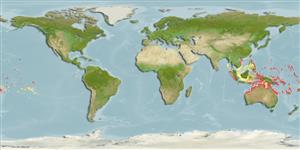Common names from other countries
>
Eupercaria/misc (Various families in series Eupercaria) >
Scaridae (Parrotfishes) > Scarinae
Etymology: Scarus: Greek, skaros = a fish described by anciente writers as a parrot fish; 1601 (Ref. 45335).
More on author: Schultz.
Environment: milieu / climate zone / depth range / distribution range
Sinh thái học
Biển Cùng sống ở rạn san hô; Mức độ sâu 2 - 40 m (Ref. 90102), usually 20 - ? m (Ref. 9710). Tropical; 19°N - 24°S
Western Central Pacific: Philippines to the Solomon Islands, north to the Marshall Islands, south to Scott Reef and the Great Barrier Reef. Recently recorded from Tonga (Ref. 53797).
Bộ gần gũi / Khối lượng (Trọng lượng) / Age
Maturity: Lm ? range ? - ? cm
Max length : 40.0 cm TL con đực/không giới tính; (Ref. 48636)
Các tia vây lưng cứng (tổng cộng) : 9; Các vây lưng mềm (tổng cộng) : 10; Tia cứng vây hậu môn: 3; Tia mềm vây hậu môn: 9. Males recognized by the yellow pectoral fins, horizontal green band from tip of snout to above pectoral fin base and large individuals with oval yellow patch on caudal peduncle. Females plain yellowish grey with pale lines along abdominal area (Ref. 48636). Scales large. Median predorsal scales 4; 3 scale rows on cheek, ventral row with 1-2 scales. Truncate caudal fin in initial phase (slightly rounded); slightly lunate in terminal phase. Dental plates nearly covered by lips. Terminal males with 1 or 2 upward-projecting canines posteriorly on lower dental plate and 1 on upper plate. Large initial phase individuals are tan while terminal phase individuals have a distinctive transparent yellowish-tan pectoral fin (Ref. 1602).
Inhabits lagoon and channel reefs, usually deeper 20 m (Ref. 9710). Minimum depth of 2 m reported from Ref. 2689.
Life cycle and mating behavior
Maturities | Sự tái sinh sản | Spawnings | Egg(s) | Fecundities | Ấu trùng
Oviparous, distinct pairing during breeding (Ref. 205).
Parenti, P. and J.E. Randall, 2000. An annotated checklist of the species of the labroid fish families Labridae and Scaridae. Ichthyol. Bull. J.L.B. Smith Inst. Ichthyol. (68):1-97. (Ref. 35918)
IUCN Red List Status (Ref. 130435)
CITES (Ref. 128078)
Not Evaluated
Threat to humans
Harmless
Human uses
Các nghề cá: Tính thương mại; Bể nuôi cá: Tính thương mại
Các công cụ
Special reports
Download XML
Các nguồn internet
Estimates based on models
Preferred temperature (Ref.
115969): 25.8 - 28.8, mean 27.4 (based on 28 cells).
Phylogenetic diversity index (Ref.
82804): PD
50 = 0.5000 [Uniqueness, from 0.5 = low to 2.0 = high].
Bayesian length-weight: a=0.02399 (0.01219 - 0.04721), b=3.03 (2.85 - 3.21), in cm Total Length, based on LWR estimates for this species & (Sub)family-body (Ref.
93245).
Mức dinh dưỡng (Ref.
69278): 2.0 ±0.00 se; based on food items.
Thích nghi nhanh (Ref.
120179): Trung bình, thời gian nhân đôi của chủng quần tối thiểu là 1.4 - 4.4 năm (Preliminary K or Fecundity.).
Fishing Vulnerability (Ref.
59153): Low to moderate vulnerability (30 of 100).
